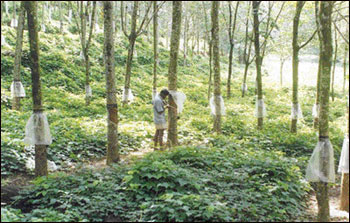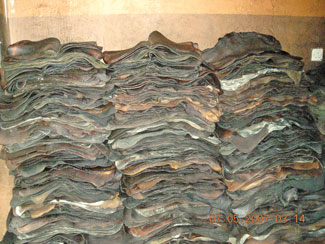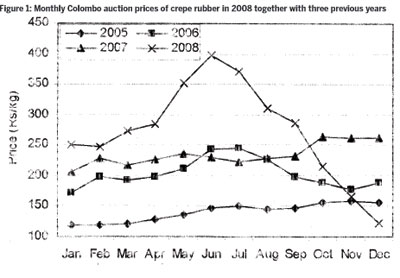Natural rubber price upswing for how long?
Dr N Yogaratnam
The upward trends in natural rubber
prices in recent times with record breaking values continue to be a hot
issue. The trend is being watched with bated breath by the suppliers and
consumers alike for contrasting reasons
Experts and stakeholders of the industry unanimously rule out a major
slide and are of the view that prices are likely to stay high till the
next few years with intermittent dips.
|

Tapping in a rubber plantation |
Natural rubber has never witnessed such a boom as it is happening
now, at least in the last few decades. The price of NR has broken all
recent records driving on supply shortage as against the ever growing
demand mainly from the tyre industry, the largest consumer of NR.
But the crucial questions are: For how long? Is the current upswing
based on fundamentals like actual demand and supply? Is there a chance
of a price crash?
Experts and stakeholders of the NR industry agree on one thing - the
prices are here to stay at higher levels at least for the next two to
three years and a major price crash is not in sight.
Price to stay high
Prices of natural rubber will continue to remain quite high well into
2011.The effect of new planting during 2005-2008 will presumably result
in somewhat lower prices starting from 2012 onwards, but it is most
unlikely that prices will collapse.
Sri Lankan rubber industry is also expected to continue to benefit
from this market boom.
It is believed that according to the present indications and
available data plus market trends, the prices are likely to soften
further.
Therefore the rubber growers will not be unhappy in the next two to
three years, which means that the prices will continue to rule at
comfortable higher levels at least as far as growers are concerned.
The Association of Natural Rubber Producing Countries (ANRPC), which
is known for its reliable and authentic perception of the NR scenario,
notes that NR prices are of late showing trends of somewhat cooling down
after its amazing bull run.
This means that the prices are set to stabilize based not only on
pure fundamentals like demand and supply but also on a host of factors
including climate change, currency volatility and speculation.
According to ANRPC statistics, global rubber prices have only fallen
of late. RSS3 price in Bangkok fell from US$ 3.52 on July 1 to US$ 3.17
on July 23.
But in Kottayam, the price has been on the rise making a wide gap
from other markets.
|

Nural rubber processing |
The gap is likely to be narrowed down as monsoon season ends in the
Kerala State by the end of September.
Indian scenario
Meanwhile, in a recent development, the Indian Commerce Ministry,
which has earlier decided to reduce the import duty on NR from 20
percent to 7.5 percent apparently on persistent demand from the rubber
products manufacturers, mainly tyre industries, has now decided to
introduce a maximum ceiling of Rs 20.46 a kg, owing to intense political
pressure and growers' resistance, while retaining the duty as such.
This Rs 20.46 a kg cap is what exactly an expert panel constituted by
the Government on a court directive, had recommended.
The news of an import duty cut had already put brakes on the soaring
NR prices in the domestic Indian market on the soaring NR prices in the
domestic market which had shot up to as much as Indian Rs 186 a kg of
late while the international prices showed a softening trend.
The Indian growers are worried that allowing import at a lower duty
would lead to massive dumping of NR from abroad which, in turn, would
lead to a price crash in the domestic market.
But the Indian Government says the measure is intended to bring down
the domestic NR prices on a par with the international prices which is
in the best interests of both the growers and manufacturers.
Sri Lankan scenario
NR prices rose by 81 percent to an average of US$ 3.27 per kg in
August this year compared to 2009.
|

Rubber collection |
At an auction in Colombo in the same month this year, prices hit an
all time record, with a kilo of crepe rubber fetching Rs 526 and this
up-ward trend continued into October with a kilo of the same grade
fetching Rs 575 .
However this trend seems to have not been maintained and prices came
down to Rs 450 per kilo before going up again to Rs 475, then to Rs 525
and in the last week of October to Rs 540 per kilo.
The period from October until January next year is the season of peak
NR production in Sri Lanka. In any case it is most likely that the
prices would stabilize around Rs 475 to Rs 500 as supply is not the only
factor that governs prices as was seen in 2008 (Figure 1).
The highest ever prices were recorded in June 2008, but it declined
sharply in October of the same year although there had been no major
shift in NR supply.
The country's export earnings have shown an increase in the first
half of 2010 when compared to corresponding period in 2009, purely due
to escalating NR prices in the global market.
As the bulk of rubber production in the country is consumed by the
domestic rubber products sector ( about 80 percent), the benefits of
improved export earnings remain restricted.
NR supply
ANRPC has pointed out right from 2007 on wards, the supply tightness
is expected to continue until 2011.
The supply after 2011, of course, depends partly on farmers' decision
on replanting of their aged trees.
Age structure of rubber trees in most of the producing countries
indicates possibility of large - scale replanting drive from the
beginning of the next decade (2011-20).
This indicates a possibility of shrinkage in yielding area until the
replanted trees attain yielding stage.
Severity of labour shortage is likely to prompt rubber farmers,
especially in Malaysia, to shift to labour saving crops such as oil palm
for which the gestation period is much shorter.
On the other side, there would be new supply from 2012 onwards. A
large extent of area was planted from 2005 onwards in response to
attractive prices. A total extent of 2.441 million hectare is estimated
to have been planted (new-planted or replanted) during 2005-2010 period
- in Thailand (0.927 million), Indonesia (0.435 million), China (0.323
million), Vietnam (0.319 million), India (0.196 million), Malaysia
(0.130 million), Cambodia (0.010 million), Philippines (0.069 million)
and Sri Lanka (0.032 million). There has been large-scale planting in
Myanmar, Laos, Cote d I'voire, Nigeria and Liberia which are countries
yet to come under ANRPC's umbrella.
Depending on the net effect of the above two opposite processes,
there could be a shift in the supply curve after 2011.
Price crash not imminent
ANRPC however, feels that the NR industry had a period (For e.g.,
April-August 2008) in which rubber market inflated without supported by
demand-supply fundamentals, taking cue from speculative boom in entire
commodity markets and even metals. But, the current recovery in rubber
prices is driven by strong market fundamentals rather than speculation.
They add that demand-supply fundamentals at least until 2011 are
likely to be favourable for rubber prices to stay high. But, it is
unrealistic to judge rubber prices on the basis of demand and supply
alone.
There are other factors influencing the rubber market, such as crude
oil price, Japanese yen, currency strength of rubber exporting
countries, commodity speculation etc.
However, possibility of a price crash in the coming years is remote
provided Asian economy stays strong.
There are actually multiple reasons behind the unusual and alarming
rise in natural rubber prices over the course of the past year. However,
the major reason is the gap between demand and supply. Not just in one
country, but globally, there is a demand-supply gap which is increasing
every day. This is fuelled to some extent by speculation, especially in
India where the rubber consuming industry is already facing the import
barrier in the form of higher Customs duty to the tune of 20 percent.
While the current good tidings in NR prices are more than soothing to
growers due to the sudden spurt in income from their good old rubber
trees, it is ironically hitting the NR consuming industry, mainly the
tyre industry, quite hard.
|

Rubber sheets |
Tyre industry's worry
Responding to the impact of the higher level of NR prices, the tyre
industry feels that, tyre, and nearly none of the natural rubber
consuming industries enjoy healthy profit margins. What this means is
even thinner margins for the consumers.
It is not possible for the NR consuming industries to pass on all the
costs since the burden would be too high. Lower profits in such a
scenario have larger implications on fresh investments in research and
development and higher capacity.
According to this industry circle, the options before the consuming
industry, especially tyre industry, is basically of tightening the belt
even more, cutting back on any expense which is not absolutely necessary
and also sweating all the assets to try and bridge this gap as much as
possible.
The other option is higher investment in research to try and find
ways of replacing natural rubber with synthetic rubber wherever
possible, without compromising any fashion aspects of safety,
performance and regulations.
It is the view of the industry that it is difficult to predict how
long the NR price will continue at higher levels. But any major economic
factor could affect prices, say for example, a slow-down; what we really
need is long term action; which means investment in a fresh crop,
increasing the acreage under cultivation, replacing older crops with
newer ones.
Simultaneously, we have to look at ways and means of replacing
natural rubber usage in tyres and allied items with synthetic rubber.
Prospects of NR substitution
On the question of substitution, it is said that, it is possible to
substitute natural rubber under certain conditions, but in Asian
countries, where the high ambient temperatures persist, substitution is
not possible after a certain point. It is easier in tyres that are used
in colder climates like northern Europe and North America.
Meanwhile, the NR industry doesn't anticipate a significant drop in
NR use following new tyre-making technologies, including new
compounding. So far, experts do not yet foresee a significant drop in NR
use: potentially only a somewhat lower growth, there are no developments
on the SR side which would have considerable impact on the NR market.
Regarding prospects of NR substitutes like Guayule, it is produced on
a small scale and we do not yet foresee large-scale production, although
very high NR prices will definitely help.
Meanwhile, ANRPC says that substitution between NR and SR is largely
a theoretical perception having limited practicability.
For instance, substitution in favour of NR was marginal in 2000 in
spite of a much lower price for NR compared to SR. Rather than relative
price, it is technical considerations that determine the proportion of
NR and SR in a product. For example, truck radials need NR in a much
higher proportion than SR.
But, this is just the opposite in the case of passenger car radials.
Technical considerations often put cap on the flexibility available for
substitution between NR and SR.
Moreover, whenever NR demand rises, SR demand also rises because the
two elastomers are together used in the manufacturing of most of rubber
products.
Enhancing production
With regard to the NR price trend, the most crucial factors will be
whether there will be enough planting, how will productivity develop,
will the number of workers be sufficient, what will be the effect of
climate change and will the disease side be under control.
Meanwhile, ANRPC prefers to describe the current uptrend in prices as
a sort of a recovery of NR prices which, is mainly driven by supply
constraints. ANRPC in 2007 itself foresaw the possibility of a tight
supply during 2007-11.
This has been due to major reasons like the increase in proportion of
low yielding aged trees in the total yielding area of all major
producing countries and slow expansion in yielding area, especially from
2006 onwards.
 Total
yielding area in the ANRPC member countries expanded only at a marginal
annual rate of 0.8 percent, from 6.788 million ha to 7.000 million ha,
during 2006 to 2010. This is due to the slow rate of planting undertaken
during the period 1999-2003 coincident with low rubber prices. Total
yielding area in the ANRPC member countries expanded only at a marginal
annual rate of 0.8 percent, from 6.788 million ha to 7.000 million ha,
during 2006 to 2010. This is due to the slow rate of planting undertaken
during the period 1999-2003 coincident with low rubber prices.
Commenting on the extension of rubber planting to low yielding
traditional areas, ANRPC says that this is due to a shift in policy
orientation of producing countries from maximizing rubber output to
maximizing farmers' profit and competitiveness.
Pointing out that this shift is not production-oriented, it says that
popularization of latex-timber clones and low-intensity harvesting
systems also largely reflect profit-oriented strategies rather than
production-oriented ones.
A marked deterioration in efficiency of harvesting due to severe
shortage of skilled trappers also affected output in major NR producing
countries, says experts and analysts.
While agreeing that climate also has affected the supply, the impact
of climate change on NR supply need not be one-directional.
For instance, less number of rainy days in June/July helps to have
more harvesting days and a better yield. This also helps in reducing
incidence of fungal diseases.
Futures trading
Regarding futures trading as a method to avert market uncertainty,
IRSG says that it could be one among the various measures that might be
very useful to reduce short-term price risk.
It cannot cure more structural shortages or surpluses in the market.
Meanwhile, what is needed is a kind of controlled futures trading in
rubber so as to ensure better price realization.
The slower growth rate of NR production capacity the world over is
the result of low levels of planting after the Asian crisis in 1997
stretching well into the first decade of this century.
Outlook
There are three main groups of factors that determine the outlook for
prices. They are: First, economic growth which impacts vehicle, tyre and
rubber consumption scenario, including the effect of availability of oil
on vehicle usage and sales.
Second, the impact on NR production potential scenario as a result of
planting policy implementation, productivity improvements and labour
availability, including the influence of climate change on NR
production.
Third is the effect of oil price, which will affect butadiene-SR
scenario. One has to see the availability and how this will affect
prices.
On the economic front, the future looks a lot better than in early
2009. However, there are still many uncertainties which may lead to a
slower recovery in parts of the world, e.g. Europe, and lower growth in
high-growth countries. This may spoil the good outlook for rubber
industry to some extent.
Another point is, the massive new planting by rubber farmers during
2005-2008. This will have a significant effect on the supply situation
starting in 2012.
The most likely scenario resulting from combining likely scenarios
based on the above three groups of factors is: prices of natural rubber
will continue to remain quite high well into 2011; the effect of new
planting during 2005-2008 will presumably result in somewhat lower
prices starting from 2012 onwards, but it is most unlikely that prices
will collapse.
The rubber prices are here to stay higher for some more time. All
indications are that the price spiral may turn around after 2012, but
will stabilize at reasonable levels that would ensure profitability to
growers and also some relief to consumers. |



